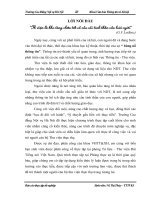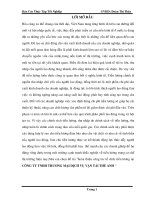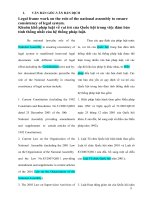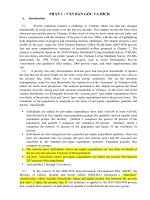Báo cáo thực tập tốt nghiệp tiếng anh (24)
Bạn đang xem bản rút gọn của tài liệu. Xem và tải ngay bản đầy đủ của tài liệu tại đây (129.25 KB, 19 trang )
VINH UNIVERSITY
FOREIGN LANGUAGES DEPARTMENT
THE USE OF SUBSTUTITION IN THE GADFLY OF
ETHEL LILIAN VOYICH
(CACH DUNG CUA PHEP THE DANH TU TRONG TAC
PHAM RUOI TRAU CUA NHA VAN ETHEL LILIAN
VOYICH)
Course Research Methodology
Date of Substitution: 02.06.2010
Student: Trơng
Thị Hơng, 48B - English
Lecture: Nguyễn
Thị Vân Lam M.A.
i
Vinnh 2010
ACKOWLEDGMENTS
For the completion of my research, I have been fortunate to receive invaluable
contribitions from many people. First of all, I should like to express my deepest gratidute to
my suppervior, Mrs Nguyen Thi Van Lam, M.A, for her absolutely indispensable assitance,
excellent suggestion, expert advice and detailed critical comments, whithout which the study
would not have been completed.
Futhermore, I would like to extend my sincere thanhks to all my friends for their
constant support and encouragement, for their books I borrowed, whithout which I would not
have enough data to finish the research.
Finally, My warmest thanks are dute to my loving parents, my older sister and my young
brother for their unconditional love, support and forbearance; to all my roomates for their
various kind of help, support and encouragement.
Vinh, May, 2010
Truong Thi Huong
ii
i
ABSTRACT
The importance of using nominal substitution in communication and learning discourse
analysis has motivated the author in the study on nominal substitution. In this work, the
author disscusses the difinition of substitution and then carries out carefuly the nominal
substitution in the typical novel of the author E.L.Voyich.
iii
ii
TABLE OF CONTENTS
Page
i
ii
iii
ACKOWLEDGMENTS
ABSTRACT
TABLE OF CONTENTS
PART I
INTRODUCTION
1. Justiication of the Sudy
1
2.Aims and Objectives of the Sudy
1
3. Methods of the Study
1
4. Scope of the Study
1
5. Format of the Study
2
PART II
INVESTIGATION
CHAPTER 1 THEORETICAL BACKGROUND
1.1. Definition of Substitution
3
1.2. Types of Substitution
3
CHAPTER 2 THE USE OF ENGLISH NOMINAL SUBSTITUTION IN THE
GADFLY
2.1. Introduction
4
2.1.1. Biography
4
2.1.2. Plot Overview
5
2.2 Genaral Features of Nominal Structure
5
2.3. The Use of Substitution Personal Pronoun in the Gadfly
5
2.3.1 The Use of Substitution Subjective and Objective Personnal Pronoun in the Gadfly
5
2.3.2. The Use of Substitution Possessive Pronoun in the Gadfly
6
2.4. The Use of Substitution One in the Gadfly
7
2.4.1. Substitute One
7
2.4.2. Substitution of Indefinite One
8
2.5. The Use of Substitution the Same
9
2.5.1. Do the Same
9
2.5.2. Linking Verbs Plus the Same
10
iv
2.6. Sumary
PART III
CONCLUTION
1. Recapitulation and Implications
2. Suggessions for Further Study
REFERENCES
APPENDIXES
1. Abbreviations and Symbols
11
12
12
13
iii
v
INTRODUCTION
1. Justification of the Study
Firts of all, English has been the most powerful language all over the world. People
learn English not only to communicate face to face but also comprehend a number of written
source of information. Especially, the treasure of English literature is a endless source for
learners to study English effectively.
Secondary, the research is that can connect together in logic order. Cohesion in English
is divided into the gramtical conhension: reference, ellipsis, substitution and lexcical
relationships (Halliday & Hasan 1976 : 6). And substitution is not studied as much as other,
especially, the use of substitution in the literature work.
Finally, the study of substitution in the literature has not gained much attention of
researchers. For this reason, our study reexamine some aspects of English substitution in the
Gadfly, one of the famous work of E.L Voynich with the highly humanitarian signficance.
For the reasons above, we decided to choose the topic “ The use of nominal substitution
in the Gadfly of Ethel Lilian Voynich” to research.
Therefore, we hope that this study can contribute on small part to help learners in using
English substitution in discourse more effectively.
2. Aims and Objectives of the Study
This study aims to:
. Provide types of English substitution, especially, nominal substitution.
This study objectives to:
. Study how nominal substitution is used in the Gadfly.
. Make some suggestions for futher study.
3. Methods of the Study
This is our qualitative research which explodes attitudes, behaviour and experiences by
some main methods: analysis method, descriptive method, synthesis method.
4. Scope of the Study
Substitution is a subject that is used to a great attention by writers and learners. It works
both in sentence and discourse. In sentence, it is obligatory and controlled by sentence
structure and consequently, it has no funtion. In dicource, sometime, it is optional and when
used, it is often for stylistic reasons and cohesive purposes. So this reseach studies
substitution as conhesive device, in which nominal substitution is major.
Next, the use of substitution in general and nominal substitution in paticular is to avoid
repetition and for replacing some gramatical items. Because of the limited size, this study
1
focus on the use of substitution in the Gadfly. And in this study beside research substitution
for nouns (one, the same), we also study personal pronoun, possessive pronoun as nominal
substitution works.
Finally, although this research is carried out with the hope to cover all the problems with
respect to nominal substitution in the Gadfly, it has some shortcomings, so it is still likely to
open up futher study.
5. Format of the Study
Except for the acknowledgement and the table of contents, the research paper includes
three main parts, a list of references and appendixes.
Part I Introduction
The introduction deals with justification of the study, aims and objectives of the study,
methods of the study, scope of the study, fomat of the study.
Part II Investigation
This part consists of 2 chapters. Chapter 1, we deal with the theoretical background of
the Eghlish substitution, chapter 2 we investigate the use of English nominal substitution in
the Cadfly,
Part III Conclusion
This part we deal with recapitulatin and implication, then we make some suggessions
for further study.
This study ends up with 2 small parts, first is references which list of sources and
materials, the last is appendixes.
.
2
INVESTIGATION
CHAPTER 1 THEORETICAL BACKGROUND
1.1. Definition of Substitution
Traditionnally, substitution has been studied as former feature within sentence. But now
it gradually is considered as cohesive device. Here is the definition of substitution which is
used mainly in our research.
In Haliday and Hasan (1976, page 90) states substitution as a gramatical relation is
accepted in the sense that the different type of substitution are defined in acucrance with the
grammatical realization of the substitute item.
1.2. Types of Subtitution
Vo Dai Quang (2004, page 20) states that most of the substitutes are pro - forms within
sentences, which can be used across sentences Types of pro - forms
- Pro - form for nouns (one/ones)
- Pro - froms for adverbials (there, like it, like that, ect)
- Pro - forms for predicate and prediction (do so, do that, do it, so…do/ does, ect)
- Pro - forms for direct object clause (so, that, ect).
Gramatically, there are four kinds of substitutions of English: a nominal group, a verbal
group, a clause, an adverbial group/ preposition phrase.
In the following chapter, we focus on the nominal substitution in the Gadfly.
3
CHAPTER 2 THE USE OF ENGLISH NOMINAL SUBSTITUTION IN THE GADFLY
2.1. Introduction
2.1.1. Biography
Ethel Lilian Voynich, (1864 - 1960) was novelist and musician, and a supporter of
several revolutionary causes. Her father was the famous mathematician George Boole. Her
mother was feminist philosopher Mary Everest, niece of George Everest and an author for the
early - 20th - century periodical Crank. In 1893 she married Wilfrid Michael Voynich,
revolutionary, antiquarian and bibliophile, the eponym of the Voynich manuscript.
She is most famous for her novel the Gadfly, first published in 1897 in the United States
and Britain, about the struggles of an international revolutionary in Italy. This novel was very
popular in the Soviet Union and was the top bestseller and compulsory reading there, and was
seen as ideologically useful; for similar reasons, the novel has been popular in the People 's
Republic of China as well. By the time of Voynich's death the Gadfly had sold an estimated
2,500,000 copies in the Soviet Union.
2.1.2. Plot Overview
The novel set in Italy in the 1800's, which was a time of revolt and uprisings and
features the hero as a mysterious satirist who is only known by his pseudonym Gadfly. At
once a romance, tragedy and heroic story, it's got passionate characters, dark secrets, betrayal
and atonement, and expertly incorporates them into the author's controversial theme - the
criticism of the church.
Two main characters of the novel are Athur and Montanelli. Arthur is a young and kind
man. He was born in an Eghlish capitalist family. Montanelli is a priest, is a head of the
theological seminary at Pisa. he treats Arthur as his son, and Arthur also loves and respects
him. Their relation is tighter after Arthurr̉s mother death. When Arthur joins in the Young Italy
with other students, they struggle for republic and have new and clearer idea for riligion, he
has changed his view with Montanelli. Five years ago, for him Montanelli was as an ideal
hero, now, he 's as a future prophet for new religion.
In the Young Italy, Arthur met and fell in love with Gemma, but she is a Protestant. In
spite of her suspicion and misunderstanding, his love for her does not change. After a
confession with a new priest of church, he was a minion of Austrian capitalism, Arthur was
captured. He not only a strong - will of revolutionary man, but also a sentiment. After that he
knew the true that Montanelli is his father. He was so upset. Everything seenmed to upside
down with him. He moved to South America, he faced difficulties and suffered pains.
However, he has never surrendered, he became wiser, and stronger with new name Rivarex or
Gadfly. He also joined in revolutionary activities. He returned to Italy to implement his duty,
4
but in here he was revealed and was in prison. In this place, he met Montanelli, they bared
their hearts but it was too late Gadfly was sentenced to death. Nevertheless, he satisfied with
this ending, he only had one wish to tell with Gemma that he loved her forever. He said:
"Then am I
A happy fly
If I live
Or if I die".
2.2. General Features of Nominal Structure
Halliday and Hasan (1976) states that there will be three main items occuring as
nominal substitutde: personal prnouns, one, the same.
they also states that the logical structre of nominal group in it full from includes three
components: the Head, the pre - modifier and the post - modifier.
pre - modifier/ Head/ post - modifier:
example: the beautiful/ girl/ on the street
2.3. The Use of Personal Pronouns in the Gadfly
2.3.1. The Use of Subtitution Subjective and Objective Personal Pronouns in thr
Gadfly
English personal pronouns are classified into two set forms: subjective personal
pronouns and objective pronouns (cited in Quirk et. al, 1972, p.208).
And now we carry out the use of english personal pronouns include subjective and
objective personal pronoun in the Gadfly
Arthur was studying philosophy at the university; and, coming to a difficulty with
a book, had applied to " the Padre" for an explanation of the point.
Montanelli was a universal encyclopaedia to him,(1) though he (*) had never
been a pupil of the seminary.
"I had better go now,” he (*) said when the passage had been cleared up;
"unless you want me for anything.(…)
"Oh, yes!" He (**) leaned back against the tree - trunk and looked up through
the dusky branches at the first faint stars glimmering in a queit sky. The dreamy,
mystical eyes, deep blue under black lashes, were an inheritance from his
Cornish mothe, and Montanelli turned his head away, that he (**) might not see
them.. (cited in Gadfly, p.10)
In that passage, we can see him (1) = Arthur = he (*); Montanelli = He(**), The dreamy,
mystical eyes, deep blue under black lasher = them.
5
The third person form, he/him, she/her are used to substitute for persons while it/it for
things. They/them replace both persons and things.
"No, Padre, I shouldn't indeed! The Warrens are very good and kind, but they
don't understand; and then they are sorry for me about mother. Gemam wouldn't,
of course; she always knew what not to say, even when were babies;” (cited in
Gadfly, p.10)
In here, we are easy to note that The Warrens = they, Gemme = she.
"oh, Padre, do come and look at this absurd dog! It can dance on its hind legs.” (cited
in Gadfly, p.18).
It replaces this absurd dog, in this case It is used to refer an animal.
In literature, we often see many authors use the third person pronoun to refer not only
person but also things, animals, This phenomenon is called personslization or non - human. It
is used in an ornate sentences to express the affectionate, beloved feeling.
"What vessel do you belong to?"
"Carlotta - Leghorn to Buenos Ayres; shipping oil one wayand hides the other.
She's over there" - pointing in the direction of the breakwater - "beastly old
hulk!" (cited in Gadfly, p.64).
We can she = vessel. In here, the third personal pronoun she/her is used to substitute for
some thing not for a singular female person.
2.3.2. The Use of Substitution Possessive Pronoun in the Gadfly
English possessive pronoun has the fllowing forms: mine, yours, his, her, its, ours, and
theirs. They can act as the Head in the nominal group and work to substitute for the
corresponding possessive adjectives plus the noun which is mentioned before to avoid
unnecessary repetition. Unlike the orther possessive pronoun, however, its functioning as the
Head is not often appeared in English.
"Because of the steamers. Arthur, don't you think your house would be safer than
ours for that work? Nobody would suspect a rich shipping family like yours; and
you know everyone at the docks ---" (cited in Gadfly, p.28).
We can see ours, and yours are the possessive pronoun. We must look back forward
sentence to consider what they replace. Ours substitute for our house, and yours substitutes
for your rich shipping family. Obviously, possessive pronouns in passage make cohesion in
separate parts of the discourse. So, in this case the possessive pronoun is observed as cohesive
devices. English possessive pronouns are anaphoric as they all substitute for both possessor
and the possessed.
2.4. The Use of Substitution "One" in the Gadfly
6
Beside the personal and possessive pronouns, in English, the lexical form one is also
found when nominal substitution would like to appear. Two types of one which can be used to
substitute for nominal group:
Halliday and Hasan(1976) states that one as a substitute for a nominal group head or the
substitute one as a substitute for an inderfinite nominal group or the indefinite one.
That is just the matter of terminology. It does not mean that the substitute one can
substitute but the indefinite one can not. But in some extent, they both replace for count nouns
but not for mass nouns or proper nouns. However if we consider carefully we can see they are
distinct in many qaws, so we must be dealt with as two separate notions.
2.4.1. One as a Substitute For Nominal Group Head
Halliday & Hasan (1976: 24), the substitute one plural form ones always keep the
position of Head in a nominal group and is always used in place of a word which itself
functions as Head of nominal group.
I have not been much in the Romagna, bit little I have seen of the people has
given me the impression that they have got, or are getting, into a mechanical
habit of violence.
Surely even that is better than a mechanical habit of obedience and submission.
I don't think so. All mechanical habits are bad and slavish, and this one is
ferocious as well. (cited in Gadfly, p. 149).
One as Head of nominal group this one substitutes for a mechanical habit of violence
which is Head of the nominal group a mechanical habit of violence .
Also from this example, it can be seen that two nominal groups may have different
function in the clause as we see that whereas a mechanical habit of voilence function as
object, this one as subject.
In Halliday and Hasan (1976: 26) states that the substitute ones/ones is a maker of a
grammatical relation since its presence in the head slot always impies that a partcular noun
functioning as Head of the nominal group in the previous discourse has been substituted and
that the noun to fill this Head slot can be found, usually, in the sentences before. Therefore,
most of the examples of the substitute one/ones are anaphoric.
Overally speaking, the substitute one/ones takes over for the Head. They do not bring
the modifying factors of the Head, but in most cases they possess their own modifying
elements instead.
I did not mean that. I would print the pamphlets openly, with our names and
addreses, and let them prosecute us if they dare.
7
“The project is a perfectly mad one," Grassini exclaimed. It is simply putting
one’s head into the lion’s mouth out of sheer wantonness. (cited in Gadfly, p. 71);
we can see that one = the project.
In the above conversation, the presupposed item
project has Deitic the as its
premodifier while the substitute one has two Epithet perfectly and mad.
Therefore, English substitute one/ones can hardly stay alone without any modification.
In some cases in which the nominal substitution with the substitute one/ones cannot occur.
With the exception os several restriction on the use of one/ones cannot take place in the
nominal compound structure. Because of a simple reason, that a word following the accented
word in a nominal structure cannot be replaced. Nor can they happen if they possess neither
the premodifier nor postmodifier - that is to say, when their forms are one and ones.
2.4.2. the Indefinite One
As mentioned above, there are two kinds of one that are indefinite one and susbtitute
one.They are viewed as two separate items is that they are different in many domains. They
are different in three main points. Firstly, Quirk et. Al (1972: 680), the indefinite one as a
substitute for an indefinite noun group can happen without a modifier but the susbtitute one
cannot do so.
(*) He took out his purse. Only thirty - three paoli; but his watch was a good
one. That would help; and in any case it was of no consequence -- he should pull
through somehow.
In the passage above, we can see that one replaces his watch.It has modification so it is
the substitute one.
(**) “You deny that it is in your writing?”
“I deny nothing. I have no recollection of it.”
“Perhaps you remember this one?”
A second letter was hander to him, and he saw that it was one which he had
written in the autumn to a fellow - student. (cited in Gadfly, p. 49).
In this case, one substitutes for a second letter, and it is as it has no modification, it is
indefinite one.
The Head noun, the same can replace for the whole nominal group. We will consider the
following paragraph in the novel to see more.
Achill, indefinable sense of something not queit the same as it had been, of an
invisible veil falling between himself and Arthur, kept him silent. (quoted in
Gadfly, p.21).
8
As we can see in the before section, most the presupposed items of the substitute
one/ones may be human, but the same is always non - human. What’s more, the presupposed
item of the same could be also an adjective functioning as an attribute when it appears as head
of a nominal group in a clause of ascription (Halliday & Hasan (1976: 107) stated that an
adjective is also one kind of noun).
The same as a substitute is quiet different from the item same in the comarative
structure.
2.5. The Use of Substitution the Same in the Gadfly
2.5.1. Do the Same
Halliday & Hasan (1976: 107) states that the same can be used in place of the fact if it
happens ‘ in the environment of the process in which a fact is involved’.
In English the same as a substitute for the fact can still be found in a number of
expressions which also substitutes for the fact. Say the same, think the same etc are the
common ones.
The same in the expression do the same, as pointed out by Halliday & Hasan (1976:
108) can take over for a process in some kinds of clause.
Isn’t there a rule to go by in your Bible, or your Missal, or any of your canting
theology books, that you must come to me to tell you what to do?
Heavens and earth, man! - Heaven’t I enough as it is, without your laying your
reponsibilities on my shoulders? Go back to your Jesus; he exacted the uttermost
farthing, and you’d better do the same. (quoted in Gadfly, p. 231).
An alternative form do the same is do likewise. The verb do can take over for a wide
range ps verbs in clause of Action (those indicate someone did something). So the expression
do the same substitute for a process.
Halliday & Hasan (1967: 108) proposed that the verb do in the same is the genenal
verb do that is phonologically salient and only takes place in those clauses of action - that
means "some one did something".
"Can't you find it, carino? Never mind: I must rewrite the passage. Possibly is
has got torn up, and I have kept you all this time for nothing." (…)
"No, Padre, I must find it; I'm sure you put it here. You will never make it the
same by rewriting". (quoted in Gadfly, p.8).
As mentioned above, the same is a form of nominal group but it can sisbtitute for a
verbal part in the clause when that part expresses a process.
9
2.5.2. Linking Verbs Plus the Same
The same, when connected with be or other linking verbs like look, sound, taste, ect.
May substitute for a noun or an adjective (and modilying elements if not left out) as Head of
the nominal group:
"How changed the Padre was! And yet his voice was not changed at all; it was
just the same as in the old days, when he used to say: "Carino". (quoted in
Gadfly, p.170), we can see that the same = his voice (noun).
"We had a barrack to sleep in at the pit 's mouth; and one night -- I had been ill,
the same as lately, and carrying stones is the blazing sun". (quoted in Gadfly,
p.234),
we can see that the same = ill (adjective).
We can see that the same is replace for a nominal group in the environment of a clause
and this is different from the substitute one/ones. The same may have different syntactical
functions as compared with that of their presupposed item. The same function as Subject
while the presupposed items may a compliment, the whole predicate or an object.
2.6. Summary
From the above investigation, we can see that nominal substitution plays an important
role process of substitution, English nominal group is considered as consisting of as its
members the presonal pronouns, the possessive pronouns, the consiting of as its members the
presonal pronouns, the possessive pronounsm, the substitute one/ones, the indefinite one/
ones and the same together with the expressions including them, especially using in the
Gadfly novel. Although they are different in many aspects, we also found some similar extent
among them.
Most instances of nominal group given out in this section are anaphotric. This reflects
the fact that nominal sibstitutiong in most cases is anaphporic, making cohesive links in
discourse. Examples cataphoric niminal substitution sometime accur, but they are not
mentined much in the novel Gadfly.
The English third pronouns in this study are restricted to the third person for the reason
that they may function as cohesive devices. the English possessive pronouns are considered as
doubly anaphoric because they substitute for both the possessed an the possessor. The
substitute one/ones is set apart from the indefinite one/ some since they different in many
aspects. The same always has non - human presupposed items, substitute for a nominal group
in the environment of a clause.The nominal substitution appears in the Gadfly with a rather
thick density. The following table of the nominal substitutes will show clearly the time of
saying in the novel.
10
Total of
Time of Saying
Possessive Pronouns
65
37,5%
One
99
56,9%
Occurrences
Same
10
5,75%
174
Table 4: Occurrences of nominal substitution in the Gadfly
As far as nominal substitution is concerned, in order to susbtitute for a nominal group in
English discourse, we may use person pronuns, one, or the same.
11
CONCLUSION
1. Recapitulation and Implication
All the presentation above is our study of nominal substitution in the Gadfly. To
conclude the study the author should like to make a brief summary of what we have done.
The study begins with an investigating of nominal substitution presented in chapter II,
the author carried out an envestigating on three main items often appearing as nominal
substitute "personal pronoun", "one", "the same" in the famous novel Gadfly of E.L.Voynich .
The paper also aims at studying prominent nominal substitute items occuring in the
novel; in the scope of the reseach the author cannot go deep into analyzing the plot of the
work.
Last but not least, important part in this section is some suggestions for further study.
In short, substitution is quiet popular phenomenom in English literatution. Dialogues
between characters make good condition for the occurrence of verbal.
Substitution, whereal nominal substitutes are mostly present in the narrator 's.
2. Suggestions for Further Study
Due to the limitation of time, the research can focus investigation on the aspects of
nominal structure in the novel Gadfly. It is hoped that further study will made on:
- Inverstigation more on the verbal, clausal, adverbial substitution in the novel 'Gadfly'.
- Comparsison between English and VietNamese substitution in the literature work
Finally, we feel that this study is far from perfect; it is, therefore, our sole responsibility
for any inadequacies and shortcoming that our research may consider to have.
12
REFERENCES
Voynich, Ethel. Lilian. (2001). Gadfly. VietNamese Version. Translated by Bac Nam and Ha
Ngoc. Ho Chi Minh: Youth Publisher.
Voyich, Ethel. Lilian. (1939). Gadfly. Oxford: University Ave.
Halliday, MAK and Hasan. Ruquaiya. (1976). Conhension in English. London: Longman
Quick, R. (1972). A University Grammar of English. London: Longman.
Le, Dung. (2006). Ngữ Pháp Tiếng Anh Diễn Giaỉ. Ha Noi: Education Publishing House.
Nguyen, Hoa. (2001). An Introduction to Semantics. Ha Noi: Viet Nam National University
Publisher.
Hornby, S. A.(2006). Oxford Advanced Learner’s Dictionary. Oxford: Oxford University
Press.
Rooy, De. Rae. (2009). Prepare for IELTS Book Two Reading and Writing. Ho Chi Minh:
Youth Publisher.
Nguyen, Lam. Van Thi, and Ngo, Phuong. Dinh. (2009). An Introduction to Research
Methodology. Vinh: Vinh University Publisher.
Vo, Quang. Dai.(2004). Discourse Analisis. Ha Noi: Ha Noi Foreign Languages University.
13
APPENDIXES
1.Abbreviations and Symboys
Etc ~ et cetera
Et al ~ and others
Substitution for ~ =
14









